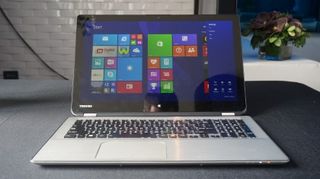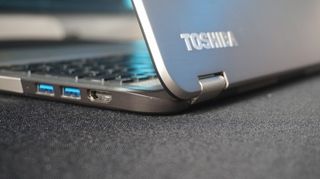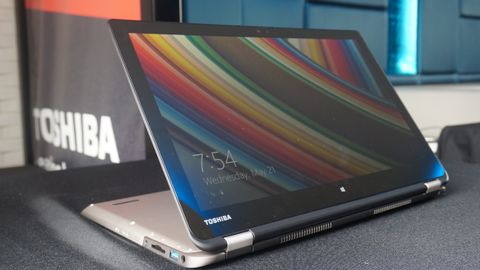Early Verdict
Toshiba's latest hybrid is large and in charge, with the hardware to back it up, but makes for an unwieldy tablet.
Pros
- +
Sharp, thoughtful design
- +
Affordably priced
Cons
- -
Makes for bulky tablet
- -
No SSD option
Why you can trust TechRadar
Hybrid devices are in, or at least getting there, since the launch of Windows 8 less than two years ago. But whether it be a detachable laptop-tablet hybrid or a convertible device, few have dared to stretch beyond 14 inches. In time for the upcoming school season, Toshiba looks to capitalize on that white space with an all new Satellite laptop-tablet hybrid.
This is the Toshiba Satellite Radius, a 15.6-inch notebook with a two-axis dual hinge that can rotate nearly 360 degrees. You know, it can do the Yoga thing, as a Toshiba representative intimated during a preview event in New York.
Sure, it can "do the Yoga modes," but it can do them at over 15 inches and in a slick, brushed aluminum frame wrapped in thin bands of rubberized plastic. Aimed at consumers and "mobile professionals" – or students, really – the Radius also comes packing an LED-backlit, frameless membrane keyboard that felt snappy enough during my brief time with the device.

But more importantly, going frameless allows for a slightly more comfortable time while switching between the different use modes that Toshiba's design allows for. Like competing convertible hybrids – the Lenovo Yoga 2 Pro, for instance – there are five modes.
More modes for more inches
Of course, the Radius will feel most at home in the standard laptop mode. Pressing back on the screen the full way around so that it rest about face from the keyboard is tablet mode. I was told that, while Toshiba doesn't see many using this mode, it's there if they so choose. (Good, because I found it rather awkward, holding a 15.6-inch slate.)

Next up is what Toshiba calls "tabletop mode," in which the device screen lays at a 180-degree angle. The company says that this should make collaborating easier with folks, say, across a meeting room table from you. This seems like it would be an incredibly situational mode, but perhaps nice to have up your sleeve.
And finally, Toshiba lists "presentation" and "audience" modes, both of which focus on consuming or watching content rather than creating it. The former sees the Radius rest on its keyboard deck, so that only the screen shows, while the latter is just Toshiba avoiding the phrase "tent mode." Lenovo got a hold of that term first, after all.

All things considered, 15.6 inches doesn't bring anything new to the table in terms of use modes, just more screen real estate, but perhaps that's all that users want. Regardless, the dual hinge on the Radius proved to be quite sturdy as I switched the device between modes. In fact, the hinge would tighten up at certain orientations for a firmer stance. Plus, those rubber "feet", if you will, that wrap the laptop's edges will certainly help prevent slipping.
A hybrid with horsepower
Of course, being a "prosumer" device (I'm so sorry), Toshiba packed the Radius with some powerful innards to make good on that promise. Powering the pixels behind a 1920 x 1080 multi-touch display is either an Intel Core i5 processor (Haswell) to start. Though, a Core i7 model will be available at launch.

Playing supporting roles are 8GB of memory and up to 1TB worth of storage – no need for an SSD in a hybrid this large, save for speed's sake. Better yet, the laptop comes sporting 802.11ac Wi-Fi along with Intel WiDi for wireless broadcasting content to other screens.
Another big plus for a hybrid this large is that there is no dearth for hard connections, with three USB 3.0 ports – one with Toshiba's Sleep & Charge function – and an HDMI-out port with 4K support. Finally, an HD webcam with dual-array microphones rounds out the package.

Early verdict
When the Toshiba Satellite Radius hits Best Buy stores exclusively early this July, it will start at $925.99. That might sound like a lot of dough, but considering that most similarly powered convertible hybrids cost more at smaller form factors, this doesn't sound like a bad deal.
Of course, that's assuming you're into the whole "hybrid" thing. This unique category has come a long way since Windows 8 graced us with its presence, with the Surface Pro 3 looking to be a shining example.
At the very least, the Satellite Radius is unique in that will be one of the few laptop-tablet hybrids on the market at 15.6 inches. Not to mention that the device has the hardware to back it up. Stay tuned for my full review to see whether this hybrid is more than just high-power.
Joe Osborne is the Senior Technology Editor at Insider Inc. His role is to leads the technology coverage team for the Business Insider Shopping team, facilitating expert reviews, comprehensive buying guides, snap deals news and more. Previously, Joe was TechRadar's US computing editor, leading reviews of everything from gaming PCs to internal components and accessories. In his spare time, Joe is a renowned Dungeons and Dragons dungeon master – and arguably the nicest man in tech.
What is a hands on review?
Hands on reviews' are a journalist's first impressions of a piece of kit based on spending some time with it. It may be just a few moments, or a few hours. The important thing is we have been able to play with it ourselves and can give you some sense of what it's like to use, even if it's only an embryonic view. For more information, see TechRadar's Reviews Guarantee.


